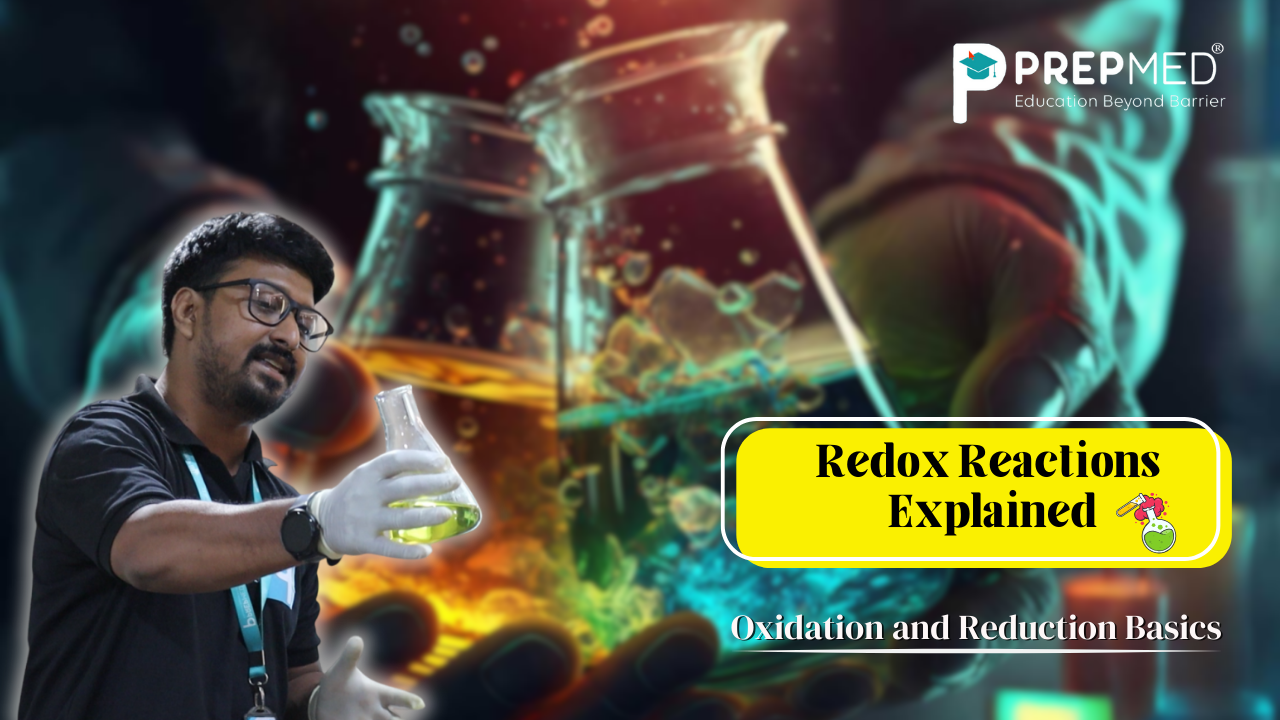January 08, 2025
Redox Reactions Explained: Oxidation and Reduction Basics
Redox or oxidation-reduction reactions are fundamental chemical processes that transfer electrons between substances. These reactions occur in many processes around us, from energy production to biological functions. Batteries power our devices, combustion fuel engines, and plant photosynthesis to make their food—all due to understanding redox reactions. In this article, we will learn about redox reactions, their types, and some real-world applications that make our lives easier and more efficient.
What is Oxidation?
Oxidation occurs when an element or compound gains oxygen and loses hydrogen or electropositive elements like metals. It is usually the addition of oxygen or the removal of hydrogen.
In modern science, oxidation is the loss of more electrons from an atom or ion. When an atom loses electrons, the ion becomes more positively charged. However, the ion's charge increases in an increasing oxidation state.
What is Reduction?
Reduction occurs when an atom, ion, or molecule receives one or more electrons from another species. When an atom or ion gains electrons, its charge decreases, resulting in a higher negative charge. This causes the element to have a lower oxidation state.
Oxidation and reduction always occur in a redox reaction (reduction oxidisation). Oxidation occurs when an atom loses electrons, and reduction occurs when another atom gains electrons.
Common Types of Redox Reactions
Redox reactions are chemical processes in which electrons are exchanged between substances as one becomes oxidised (loses electrons) and the other becomes reduced (gains electrons). Redox reactions are numerous we encounter them in many different chemical processes. Let’s break them down in a simple and detailed way.
Synthesis (Combination) Reactions
A combination reaction occurs when at least two reactants mix and react chemically to form a new chemical compound. During this process, one element loses electrons (oxidation), and another takes up electrons (reduction). This common type of reaction occurs when two elements or compounds combine to make something new.
Example:
Hydrogen gas and oxygen gas always react to form water.
2H2+O2→2H2O
Here, hydrogen is oxidised (takes away the electrons), and oxygen is reduced (gives electrons) to form the water.
Decomposition Reactions
The decomposition reactions are reactions in which a single compound splits into two or more products. One element may lose electrons (oxidation), while another may gain electrons (reduction). In other words, one thing splits into more minor things.
Example:
Heated mercury (II) oxide will give mercury and oxygen.
2HgO→2Hg+O2
Here, oxygen is reduced (gains electrons) while mercury oxidises (loses electrons) during the reaction.
Displacement Reactions
Displacement reaction- in which one of the elements displaces another directly from its compound. These reactions are of two types:
- Single Displacement Reactions: In a compound, one element replaces another.
Example:
When zinc is placed in a copper sulfate solution, zinc replaces copper.
Zn+CuSO4→ZnSO4+Cu
Zinc is oxidised (loses electrons) to copper metal and copper(II) ions are reduced (gain electrons).
- Double Displacement Reactions: One undergoes a redox change, and two compounds exchange parts.
Example:
In the reaction between silver nitrate and sodium chloride, silver replaces sodium.
AgNO3+NaCl→AgCl+NaNO3
Silver gets reduced (gains electrons), and sodium gets oxidised (loses electrons).
Combustion Reactions
Redox reactions occur when a substance (often wood or methane as fuel) burns rapidly with oxygen to release heat and light. They are exothermic reactions that require a lot of energy. Oxidation can also be defined as one of several combustion processes in which oxygen enters a substance.
Example:
When methane (natural gas) burns in oxygen, it forms carbon dioxide and water.
CH4+2O2→CO2+2H2O
In this case, methane is oxidised (loses electrons), and oxygen is reduced (gains electrons).
Titration Reactions (Redox Titrations)
Redox titrations use a redox reaction with a known concentration substance to determine the concentration of a substance. In these reactions, one substance is oxidised, and the other is reduced. This type of reaction is used in labs to determine the amount of chemicals in a solution.
Example:
Iron titration with potassium permanganate oxidises iron(II) to iron(III), whereas potassium permanganate acts as the oxidising agent since it gets reduced. Potassium permanganate estimates the amount of iron present in the solution.
Galvanic cells and Electrolysis
Electrochemical reactions are performed using devices like batteries and electrolytic cells. The reactions above usually involve the transfer of electrons through an external circuit between the two electrodes within these cells. Thus, one electrode in such a cell is termed an anode, while the other is called a cathode. Oxidation occurs at one end, and reduction occurs at the other.
Galvanic Cells are spontaneous redox reactions that generate electricity, such as in a battery. One of the two electrodes loses electrons during oxidation, and the other gains electrons during reduction.
- Example: In a simple zinc-copper battery, zinc is oxidised at the anode, and copper ions are reduced at the cathode.
Electrolysis involves using electricity to drive a non-spontaneous redox reaction, such as splitting water into hydrogen and oxygen gas.
- Example: During water electrolysis, water is oxidised at the anode to give oxygen, while hydrogen ions are reduced at the cathode to form hydrogen gas.
Redox Reaction Applications
Redox reactions play a key role in many processes we encounter every day. These reactions, involving the transfer of electrons, are essential in various fields, from energy production to biological processes. Here are some simple and easy-to-understand applications of redox reactions:
Electrochemistry (Batteries) Redox Reactions
The batteries we use in our daily lives are mostly redox reactions. Electrochemical cells or batteries function by converting redox-reactions chemical energy into electric energy. Take, for example, an essential battery such as that inside a remote control or a watch, where oxidation occurs at one end (anode) and reduction at the other (cathode).
In a Daniell cell, which is a particular type of electrochemical cell:
- At the anode, zinc loses electrons and gets oxidised: Zn(s)→Zn2+(aq)+2e−
- At the cathode, copper gains electrons and gets reduced: Cu2+(aq)+2e−→Cu(s)
The overall reaction in the Daniell cell is: Zn(s)+Cu2+(aq)→Zn2+(aq)+Cu(s)
This is how batteries make electricity for devices.
Redox Reactions in Combustion
Combustion is another common reaction classified under redox reactions, i.e., one that involves the response of a substance with oxygen with the release of energy. For example, when methane (natural gas) burns in oxygen, the following redox reaction occurs: CH4(g)+2O2(g)→CO2(g)+2H2O(g)
In this reaction:
- It reduces (takes in electrons) oxygen (O₂).
- These two, carbon (C) and hydrogen (H), are oxidised (they lose electrons).
For cooking, heating, and even in space rockets, the energy needed comes from combustion reactions, such as the reaction of a mixture of ammonium perchlorate and aluminium powder that powers the rocket.
Photosynthesis Redox Reactions
Photosynthesis is a redox process of vital importance to plants, which produce food for plants and animals. The overall reaction looks like this: 6CO2(g)+6H2O(l)--->C6H12O6(aq)+6O2(g)
In this reaction
- H₂O is oxidised (loses electrons) to O₂.0
- 12It reduces (gains electrons) carbon dioxide (CO₂) to glucose.
This process is essential for the earth's life; it oxygenates the atmosphere and contributes to the food supply.
Redox Reactions in Photography
Silver bromide (AgBr) is a very significant constituent in photography. Therefore, if photosensitive silver bromide on photographic film is struck by light, it would also undergo redox.
- The reduction (gaining electrons) of silver bromide to form silver metal.
- Bromine is oxidised (loses electrons) and gets released.
This process allows us to capture and develop photographs.
Conclusion
Redox reactions are important in many processes that affect our daily lives, such as energy production and biological processes. They happen constantly, whether the battery in your remote or the photosynthesis that allows life on Earth to continue.
If you are preparing the chemistry syllabus for NEET 2025 but cannot comprehend the problematic and complex rules, check out the complete resources and study material by experts in chemistry only at PrepMed.
FAQs
1: What are the rules of oxidation?
A: Here are the basic rules for determining oxidation states:
- In its natural form, the oxidation state of an element is 0 (e.g. O₂, N₂, H₂).
- The oxidation state of a monoatomic ion is its charge (Na⁺ = +1, Cl⁻ = -1).
- Oxygen usually has an oxidation state of -2, but -1 in peroxides and when combined with fluorine.
- Hydrides (NaH, for example) are -1, but hydrogen is usually +1.
- In the neutral compound, the sum of oxidation states is 0, and the sum of oxidation states in a polyatomic ion is equal to the charge of the ion.
2: What is the principle behind redox reaction?
A: A redox reaction is a principle where electrons are transferred between substances. One substance gives up electrons (oxidation), and the other gains electrons (reduction). The simultaneous nature of this electron transfer is because, for one substance to lose electrons, another must take them. That’s why oxidation and reduction always happen together in a redox reaction.
3: What is a redox reaction fundamental?
A: A redox reaction (or reduction-oxidation reaction) is a chemical process in which one substance loses electrons (oxidation) and another substance gains electrons (reduction). These reactions always happen together; when one element loses electrons, the other must gain them.
4: Why is a reaction redox?
A: To identify if a reaction is a redox reaction, look for changes in oxidation states (charge) of the elements involved:
- Oxidation is when one element’s oxidation state increases (loses electrons).
- Reduced means that another element’s oxidation state has decreased (gained electrons).
If a reaction is redox, it must involve both simultaneous processes that take place in that reaction.






